Our Lovely Man from the North Country
Written by Deborah Shaw posted on June 13, 2013 07:27
Frederic Sackrider Remington was born in a tumultuous year at the beginning of the American Civil War on October 4, 1861 to Seth Pierre Remington and Clara Bascomb Sackrider. Captain Seth Pierre Remington of the 11th Cavalry did not meet his son until after the war. Frederic so admired his father and was “steeped in the Civil War and raised, full of yearning and admiration in soldiers and the (grand frontier.)11 Frederic was an only child who was showered with attention, approval and love. He was also fortunate to be born in Canton, New York in the Adirondacks, which was known as the North Country. The North Country belonged to the majestic St. Lawrence River and to the woods.22 The North Country was a land “of river and woods that ran from the Northern Adirondacks to the Canadian border.”33
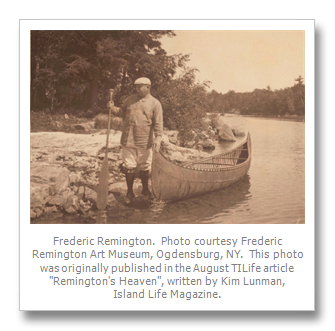 The Adirondacks in earlier years had been the home to the Iroquois Indians and was still a primeval, pristine world of rivers, lakes and trees. In other words, everything a young boy would long for and cherish while swimming, fishing and camping. The young Remington and his friends would play cowboys and Indians. He once even took his playing to heart and clipped off all of his friend’s hair. 44 As a child, Remington was not particularly well liked by anyone. He was a prankster and once even painted a cat green. 55 Life went on and although he was the scourge of young ladies everywhere he did manage to make many male friends and when he was not pretending to scalp his friends, fishing or camping, he was drawing. 66
Frederic Remington was also a poor pupil and in particular with mathematics. Although his father tried desperately to tutor his son, Frederic was just obtuse with all mathematical subjects. 77 He did however excel at English Composition. Frederic attended Highland Military School, in Worcester, Massachusetts. The cadets remembered him because he was happy, generous and pleasant to be around, and gave away sketches but made a poor clumsy soldier. 88 He had intended to apply to go to Cornell because he wanted to be a journalist like his father. Remington discovered Cornell had no art program so he applied and was accepted at Yale School of Fine Arts. 99 The only opportunity within his reach to study art formerly was at Yale who had founded an art school in 1864. 1010 In 1878, there were thirty art students at Yale and twenty-three of them were woman. 1111 Remington had disdain for the self-discipline of Yale’s classical European art master John Henry Niemeyer. 1212 However, he loved playing the part of a Yale man. 1313 Remington did get involved in illustrating for the school paper and “in 1878 the student newspaper Yale Courant printed Remington’s first published illustration, a cartoon for the college series (College Riff-Raff). 1414
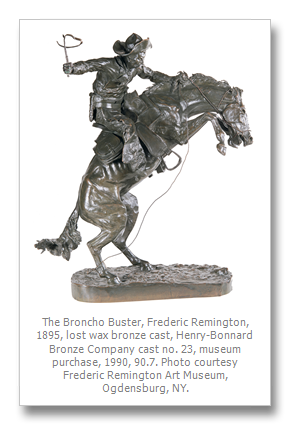 Frederic Remington returned home in the summer of 1879 showing all how upwardly mobile the Remington family had become by having a Yale man in the family. While in the North Country he was able to camp by his beloved St. Lawrence River at “Prison Island one of the Thousand Islands.” 1515 The Thousand Islands are Rock Masses in the St. Lawrence River and many were then still covered with primordial forests. Remington loved this area and would return many times. 1616 In 1900, Remington would acquire a six-acre island of his own, which he called Ingleneuk, in Chippewa Bay on the St. Lawrence River where he was to pass some of his happiest summers. 17 While Frederic was home, he met Eva Caten. Remington was smitten with her right from the start and he knew that only Eva would do as his mate. He called on her every day while at home and they began “keeping company.” 1818 As summer drew to a close, the smitten Remington returned to Yale. Never keen on his formal art education, he was very happy to become a member of the Yale football team, and in fact, he thrived at it. He played so ruggedly that even his Art professor, whilst gazing upon a black and blue Remington told him “he was indeed the most unusual art student he had ever had.” 1919 In 1879 Yale was regarded, as the best football team in the country, and Remington was always extremely proud to be a part of it. At the end of the season, Remington returned home and never returned to Yale.
Remington’s return to Canton was possibly the worst time of his life. His father, who he adored, had been diagnosed with Tuberculosis, and he could only watch helplessly as his father weakened and died. Remington’s luck went from bad to worse when he wrote to Eva Caten’s father asking for permission to marry Eva. The letter he received in return was a resounding no. Although Caten had many reasons to disapprove of a marriage he primarily thought Remington at 18 was too young to marry.
As Remington waited for his inheritance from his father he enjoyed traversing all over the North Country and camping up and down the St. Lawrence River and took a brief trip to Montana. As soon as Remington came into his inheritance at age twenty-one “he took off immediately for Kansas, a sheep farm, and a string of misadventures.” 2020 Neither his mother nor Eva Caten were interested in his artistic pursuits and certainly did not encourage him to follow that path. While contemplating his future in 1885 at Kansas City, he bought a horse and literally rode off to meet his fate in the West. Always the Yale man, he was of course wearing a Pith Helmut rather than a cowboy hat. 2121 Remington’s failures were a gift to America, the world and the effort to preserve the Old West for future generations. While many thought of the West as expanding our horizons, Remington knew the real West was dying and was focused on recording the vision of this amazing land for the future.
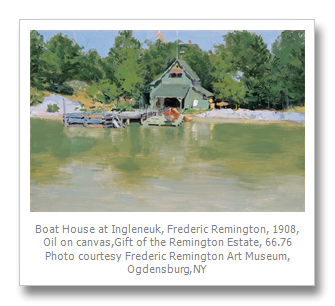 When Frederic Remington came of age in the 1880s, life was exciting and ever changing with amazing inventions and modern day wonders being built. At the same time a Georgia pharmacist invented Coca-Cola, a carbonated beverage and began to advertise Coca-Cola in the Atlanta Journal. Construction of the Panama Canal had begun, Thomas Edison and Alexander Graham Bell formed the Oriental Telephone Company, and in 1885 AT&T is incorporated, and immigrant Emile Berliner patents the gramophone. Additionally, Edison invents the phonograph and begins work on the first motion picture camera. New “wonders” of the world appeared in the form of the Brooklyn Bridge and the Statue of Liberty. 2222
Although the times were a technological renaissance, these were also times of violence. There was an infamous gunfight at the O.K. Corral in Tombstone, Arizona, and President Garfield had been shot. Sioux Chief Sitting Bull surrendered and was killed in 1890, and Western outlaw Jesse James was shot to death by a member of his own gang for a $5,000 reward. In 1885, white miners in Wyoming attacked Chinese coworkers, killing twenty-eight and forcing several more to leave. The following year the Haymarket riot and bombing took place in Chicago giving birth to the American Federation of Labor (AFL). These were the volatile, yet innovative years of Remington’s youth in America. 2323
Remington proposed to Eva Caten again in 1884, and this time she accepted. Although Remington had dissolved his sheep farm, he did manage to purchase a saloon in Kansas City. Caten did not know about the saloon when they wed, but she soon found out and left Remington to fend for himself while she returned east. 2424 Remington left Kansas City in 1885, wandered the desert for several months, musing about his life and returned home to reclaim his wife. This would be the nudge that Remington needed to make art his full time career. As fate would have it, once he decided on devoting himself to his craft, his rise to fame would be nothing short of meteoric. 2525 Remington made the rounds of publishing houses in New York with his Western portfolio just as the Apache War rekindled an interest in the American West with her cowboys and Indians. Geronimo and Buffalo Bill Cody were the names on everyone’s tongue and Remington was best know for capturing images of the West as was therefore in demand. 2626 Frederic Remington first proved his talent as a black and white illustrator for Harper’s Weekly and Outing. His former classmate (Poultney Bigelow) who was the editor of the Outing said “It was as though he had given me an electric shock … here was the real thing, the unspoiled native genius deal with Mexican ponies, cowboys, cactus, lariats and sombreros. 2727
Americans kept expanding and moving West, once gold was discovered in 1849. They did so at a cost to the “Indians” There were stories of the West, which rivaled the legends of Prestor John, Johnny Appleseed, and Paul Bunyan. The vehicles that brought this story alive were magazines such as Harper’s Weekly, Outing and Century Illustrated Magazine. The man who presented this story of a disappearing frontier was Yale dropout, Frederic Remington. Remington illustrated a number of articles on the West written by a young Theodore Roosevelt. 2828 Remington provided real images and sculptures of the West to tell the story of a land that was out of reach for most Americans. Remington had arrived. Whether an author of fiction, or non-fiction every single writer who wrote of the West wanted Remington to be the illustrator. On the rare occasion Remington had no work to illustrate, he was would write his own stories to illustrate. 2929 When people thought about the West, they could not do so without thinking about Remington.
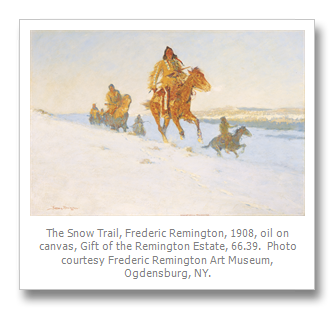 In 1900, Remington purchased a small island, Ingleneuk, in Chippewa Bay on the Saint Lawrence River, where he spent summers. Some of the happiest moments in Frederic Remington’s life were at his beloved Ingleneuk. He delighted in swimming, fishing, or paddling in one of his beautiful cedar canoes. 3030 This was Remington’s boyhood home and no place was closer to his heart than the North Country.
One can only imagine the awe of people in the nineteenth century when they first viewed Remington’s images of buffalo, the prairie, “Indians,” cowboys, and horses that appeared to fly. Remington was the first artist to accurately capture the true gait of horses. 3131 Remington’s contrast between the soft colors and impressionistic feel of his paintings, and the sharp focus in his sculptures are a suitable representation of the evolution of his attitude toward Native Americans from thinking of them as savages to having “an admiration for their physical prowess and bravery.” 3232 Remington once told a friend if he could have anything written on his tombstone, it would be “He knew the horse.” 3333 Remington really did know the horse and was the first artist to show the horse with all four feet off the ground, and he was vey proud of this.
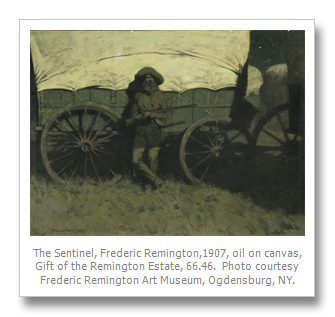 The American West was as far from Canton, New York as one could get. This spirited young artist metamorphosed from a rambunctious young man to an extraordinary artist who would excel in the art forms of the illustration world of black and white, the magnificent colors of day and night, and the sharp angular cast of bronze sculpture, as well as the written word. It was because Remington was a man of many worlds and full of contradictions that the Easterners would embrace his Western art. He had been to and captured images of places, which people in the East could only dream about. Remington, “The “fat Easterner” proved to other Easterners that the West could be theirs as well for the taking.” 3434 Remington’s assignments had taken him all over Western states, Canada and Mexico. He had even covered the Sioux Ghost Dance Wars of 1890-1891 and Custer’s Last Stand. 3535 The West was now won or as people have come to understand, and as Frederic Remington intuitively knew, the west was now lost. Theodore Roosevelt said of Remington, “He is, of course, one of the most typical American artist we have ever had, and he has portrayed a most characteristic and yet vanishing type of American life. The soldier the cowboy and he rancher, the Indian, the horses and the cattle of the plains, will live in his pictures and bronzes, I verily believe, for all time.” 3636 This is extremely important because Theodore Roosevelt was considered an expert on the West and he and Remington had been friends as well as collaborators on articles by Roosevelt and illustrations by Remington.
Remington was at a crossroads and America was fortunate that he turned his talents to capture images of his first love of the North Country and wrote of wilderness that always inspired him. Remington also moved to Nocturne (night paintings) and sculpting. 3737 Remington was now a man who could work in many artistic medians. No matter what median he was using, (water color, oil, black and white illustrations, clay, bronze, or words), the end result was always one of wonder and beauty. To gaze upon a beautiful western pieces of art, a magical image of the Adirondacks, a painting with colors of the night or to gaze upon the beautiful hard lines of a bronze cowboy taming a bronco, was to make one wonder how one man could have honed the skills to work in many different medians to make all theses magnificent creations. There are no words to describe the scope and beauty of his legacy.
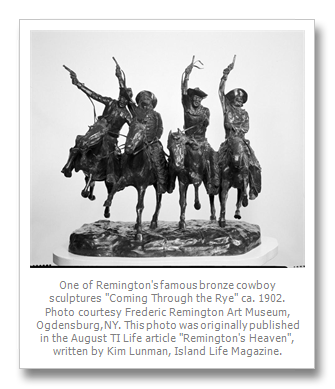 There are many who say Frederic Remington was a bigot. Perhaps he was just a man of his times. America was home to many immigrants and many people supported the Chinese Exclusion Act of 1882, which limited the number of immigrants into the U.S. 3838 It is said that he “despised much of mankind” 3939 and he had been known to refer to people pouring into Ellis Island as Italians, Jews, “stinking” Russians, “Polacks”, and Hungarians. Remington called them the “Rubbish of Europe” 4040 Remington once wrote about the Pullman Strike riots in Chicago of 1894 which was the first national strike in the U.S. “150,000 persons and twenty-seven states and territories and would paralyze the nations railway system. The entire rail labor force of the nation would walk away from their jobs.” 4141 Twelve people were killed, and many more injured. Remington referred to the Calvary as “tall bronzed athletes,” and the “malodorous crowd of anarchistic foreign trash.” 4242 Sadly it was not uncommon for people of these times to forget that they all came from somewhere else initially.
One of the most important years of Remington’s work was in 1895. This is the year he published a book, published fifteen magazine pieces, painted The Fall of the Cowboy and sculptured his first bronze titled The Bronco Buster. The Bronco Buster remains one of his most popular sculptures ever. 4343 This amazing man could use his hands to create stories of a dying land, images with watercolors and oil of a land soon to disappear and sculpt images of men busting broncos or horses flying with all four feet off the ground. His depth and creativity in all forms of art is something that one cannot even imagine until his legacy is explored. Theodore Roosevelt on November 28, 1897 gave Frederic Remington this unsolicited compliment. “You come closer to the real thing with the pen than any other man in the western business.” 4444
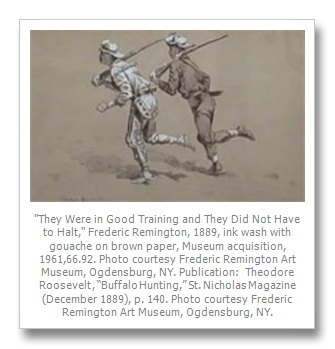 Although the years artistically had been kind to Remington he was very distressed due to his obesity and drinking. Remington was not a healthy man and he desperately feared getting old. Remington was constantly frazzled and fretted about something. It is as if he seemed happy when “longing for a real blood letting” came to be in the form of the revolution in Cuba. He was bitterly disappointed not to have seen any action other than the strip search of a female that he rendered for the Journal, which sold nearly a million copies. 4545
He was a gifted man who bequeathed to America a world that would be lost to us had he not endowed us with over 3000 images, many sculptures and numerous writings. 4646 Frederic Remington left us the gift of seeing, feeling, and being in the moment of the old American West. He left us a moment in time, which is lost but thankfully remarkably preserved, through his life works. One can look at one of his images and be there, feeling the beauty, the arid climate and timelessness of another world. One can pick up a book of Remington’s stories and time travel to another time and place. One can look at his images of Crazy Horse’s camp and read about his time hours after Custer’s last stand. 4747 This gift gives us a pure, clear picture of a moment in history when the west was not won, but the west was lost. This West may be gone, but thanks to Remington, it lives in our hearts and can be recalled in an instant simply by gazing at an image of a dry hot day and a cowboy or Indian riding through the desert with golden sand and an azure blue sky. This was the great American Frontier. This was the land that was the last place for our indigenous people to hope that by dancing a ghost dance, things would be beautiful again for all the Native Americans and this was the place that would be gone forever as soon as gold was discovered and the white man pushed further and further west. This man leaves us with a final image of when two cultures collided and the beauty, valor and violence of this beautiful part of America.
Remington died of appendicitis in 1909 at the age of 48. Theodore Roosevelt eulogized him saying, “The soldier, the cowboy and rancher, the Indian, the horse and the cattle of the plains will live in his pictures, I verily believe, for all time.” 4848
|
Bibliography
"American Masters - Frederic Remington." PBS. February 17, 203. Accessed March 24, 2013. http://www.pbs.org/wnet/americanmasters/episodes/frederic-remington/about-frederic-remington/688/.
"America's Best History U.S. Timeline, The 1880's." America's Best History U.S. Timeline, The 1880's. Accessed January 20, 2013. http://americasbesthistory.com/abhtimeline1880.html.
"Chinese Exclusion Act (1882)." Open Collections Program: Immigration to the US,. Accessed March 19, 2013. http://ocp.hul.harvard.edu/immigration/exclusion.html.
Dippie, Brian W. "Introduction." Introduction to The Frederick Remington Art Museum Collection, 13. New York: Harry N. Abrams, 2001.
"Frederic Remington and the American Civil War: A Ghost Story." Frederic Remington and the American Civil War: A Ghost Story. Accessed March 24, 2013. http://www.tfaoi.com/aa/6aa/6aa346.htm.
"Frederic Remington." Frederic Remington. Accessed January 24, 2013. http://hoocher.com/Frederic_Remington/Frederic_Remington.htm.
Manley, Atwood, and Margaret M. Mangum. Frederic Remington and The North Country. First ed. New York: E.P. Dutton, 1988. Manley, Atwood, and Margaret Manley. Mangum. "Introduction." Introduction to Frederic Remington and the North Country, Xix. First ed. New York: Dutton, 1988.
McCullough, David. "The Man." Frederick Remington: The Masterworks, by Michael Edward. Shapiro and Peter H. Hassrick, 19. New York: Harry N. Abrams, 1988.
"THE PULLMAN STRIKE." Pullman Strike, Chicago, 1894. March 03, 1998. Accessed March 19, 2013. http://www.kansasheritage.org/pullman/index.html.
Remington, Frederic, and Brian W. Dippie. The Frederic Remington Art Museum Collection. New York: Frederic Remington Art Museum, 2001.
Remington, Frederic. "The End of Our Indian Wars." Frederic Remington's Own West;, 254. New York: Dial Press, 1960.
Samuels, Peggy, and Harold Samuels. "The Acting Corporal." In Frederic Remington: A Biography, 23. First ed. Garden City, NY: Doubleday, 1982.
Shapiro, Michael Edward, and Peter H. Hassrick. Frederic Remington: The Masterworks. New York: Abrams, 1988.
|
By Deborah Shaw
Deborah Shaw is a non-traditional student at age sixty-one where she is attending Flager College in St. Augustine, Florida after having had a full business career working as a senior manager with AOL LLC, Dulles, Virginia and Brand Manager at Digital Equipment Corporation, Merrimack, New Hampshire.
Deborah attended Université du Censier in Paris, France and Northeastern University, Boston, MA. And now completing a new degree at Flagler College. This winter she was asked to write a paper on a character from the 19th Century American West. She wrote, “ Given my age, I could not get beyond the theme songs of many of the “Cowboy” shows that I grew up with. My Professor, Steven Voguit, suggested Frederic Remington as a topic. I fell in love with the artist, his colors and the images he left behind of both the American West and the North Country. Writing about Remington was to discover the artist and this has indeed been a gift.
Author’s Note: I wish to thank the staff members from the Frederic Remington Art Museum. Laura Foster at the Remington Museum was an amazing help to me. I also thank Susan Smith editor of Thousandislandslife.com. They both suggested a number of important references and material for my paper.
___________________________________________________________________________________________________
“The Frederic Remington Art Museum is dedicated to collecting, exhibiting, preserving and interpreting the art and archives of Frederic Remington, and contains an unmatched collection of his works. The Museum is open October 15 through May 15, Wednesday through Saturday, 11 am to 5 pm and Sunday, 1 to 5 pm and May 16 through October 14, Monday through Saturday, 10 am to 5 pm and Sunday, 1 to 5 pm. The Frederic Remington Art Museum is located at 303 Washington St. Ogdensburg, NY, 13669, for information see. www.fredericremington.org” |
1
Peggy Samuels and Harold Samuels, "The Bonfire," in Frederic Remington: A Biography, First ed. (Garden City, NY: Doubleday, 1982), 13.
3
Atwood Manley and Margaret M. Mangum, Frederic Remington and The North Country, First ed. (New York: E.P. Dutton, 1988), Jacket.
6
Peggy Samuels and Harold Samuels, "The Bonfire," in Frederic Remington: A Biography, First ed. (Garden City, NY: Doubleday, 1982), 12.
14
Frederic Remington and Brian W. Dippie, The Frederic Remington Art Museum Collection (New York: Frederic Remington Art Museum, 2001), 19.
17
David McCullough, "The Man," in Frederic Remington: The Masterworks, by Michael Edward. Shapiro and Peter H. Hassrick (New York: Harry N. Abrams, 1988)
20
David McCullough, "The Man," in Frederic Remington: The Masterworks, by Michael Edward. Shapiro and Peter H. Hassrick (New York: Harry N. Abrams, 1988), 15.
22
"America's Best History U.S. Timeline, The 1880's," America's Best History U.S. Timeline, The 1880's, 1880s, accessed January 20, 2013, http://americasbesthistory.com/abhtimeline1880.html.
24
Frederic Remington and Brian W. Dippie, The Frederic Remington Art Museum Collection (New York: Frederic Remington Art Museum, 2001), 19.
27
Frederic Remington and Brian W. Dippie, The Frederic Remington Art Museum Collection (New York: Frederic Remington Art Museum, 2001), 17.
28
David McCullough, "The Man," in Frederic Remington: The Masterworks, by Michael Edward. Shapiro and Peter H. Hassrick (New York: Harry N. Abrams, 1988), 19.
29
Michael Edward. Shapiro and Peter H. Hassrick, Frederic Remington: The Masterworks (New York: Abrams, 1988), 32.
30
Frederic Remington and Brian W. Dippie, The Frederic Remington Art Museum Collection (New York: Frederic Remington Art Museum, 2001), 18.
33
Michael Edward. Shapiro and Peter H. Hassrick, Frederic Remington: The Masterworks (New York: Abrams, 1988), 65.
36
Michael Edward. Shapiro and Peter H. Hassrick, Frederic Remington: The Masterworks (New York: Abrams, 1988), 29.
38
"Chinese Exclusion Act (1882)," Open Collections Program: Immigration to the US,accessed March 19, 2013, http://ocp.hul.harvard.edu/immigration/exclusion.html.
39
Michael Edward. Shapiro and Peter H. Hassrick, Frederic Remington: The Masterworks (New York: Abrams, 1988), 29.
41
"THE PULLMAN STRIKE," Pullman Strike, Chicago, 1894, March 03, 1998, 1, accessed March 19, 2013, http://www.kansasheritage.org/pullman/index.html.
44
Michael Edward. Shapiro and Peter H. Hassrick, Frederic Remington: The Masterworks (New York: Abrams, 1988), 24.
45
Peggy Samuels and Harold Samuels, Frederic Remington: A Biography, First ed. (Garden City, NY: Doubleday, 1982), Image 41.
46
"American Masters - Frederic Remington," PBS, February 17, 203, Frederic Remington, accessed March 24, 2013, http://www.pbs.org/wnet/americanmasters/episodes/frederic-remington/about-frederic-remington/688/.
47
Frederic Remington, "The End of Our Indian Wars," in Frederic Remington's Own West; (New York: Dial Press, 1960), 254.
48
"Frederic Remington and the American Civil War: A Ghost Story," Frederic Remington and the American Civil War: A Ghost Story accessed March 24, 2013, http://www.tfaoi.com/aa/6aa/6aa346.htm.
Please feel free to leave comments about this article using the form below. Comments are moderated and we do not accept comments that contain links. As per our privacy policy, your email address will not be shared and is inaccessible even to us. For general comments, please email the editor.
Comments
Comment by: Paula Cornelius ( )
Left at: 10:56 AM Monday, June 17, 2013
Congratulations Deb, what a great article about a great man. What an adventurous life he lead, I was not familiar with his work and life until I read your article. I thoroughly enjoyed learning about him. Well done!
Comment by: Vicki ( )
Left at: 9:09 PM Tuesday, June 18, 2013
Deb--This is such an intriguing article! In addition to fascinating, little-known details about Remington as an artist, I really love the sociopolitical elements you've elucidated. So fascinating! I look forward to reading more from you.
Comment by: Steve Glazer ( )
Left at: 10:07 PM Friday, June 28, 2013
Nice article! A clarification concerning Remington's father, Seth Pierre Remington. Although he was initially commissioned a captain of company D of the 11th New York Cavalry in the first year of the Civil War, he rose to major the following year, and served in that grade until mustered out in March 1865.
Comment by: Deb Shaw
Left at: 7:29 AM Saturday, June 29, 2013
Oh thanks Steve! I'll put that in my notes! I just love his work.
Comment by: Kelly Thompson ( )
Left at: 12:51 PM Thursday, July 4, 2013
Thoroughly loved the article! Incredible job Deb! Such a writer you are. With me only being a sometimes history buff, you made me thirsty for more! What a great story, about a great man! Makes me proud to be American. Keep up your wonderful passion!
Comment by: Kevin Ip ( )
Left at: 4:10 PM Thursday, July 11, 2013
I had to read this article twice to truly appreciate the content. The first time around, I was just amazed at the writing. Having seen your writing over the course of two years, I'm happy to say that there has been an extreme improvement and now you're publishing these fascinating articles. It truly is an honor to read your writing and to think you brag about my skills? My skills pale in comparison to this masterpiece. You've captured a life as any picture could. Your writing leaves a photographic description that no words can recreate. Beautiful job, Deb. I can only be happy for you!
Comment by: Deb Shaw ( )
Left at: 5:26 PM Thursday, July 11, 2013
Kevin what an honor to have your feedback. I absolutely have learned so much from my fellow students at Flagler College who are so much younger and so talented. You are still the most talented writer at Flagler and I hope you will learn more about the Thousand Islands and the Adirondacks and put it on your places to explore!
Comment by: Eddie Lawton
Left at: 9:39 AM Saturday, July 13, 2013
This is an excellent article Deb! I did not know much about Frederic Remington until now! Wicked excellent!
|